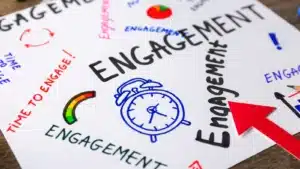
Team Icebreakers That Go Beyond Small Talk and Drive Real Talk
Engaging in meaningful conversations can significantly enhance team dynamics and foster a more collaborative work environment. While small talk serves its purpose, it often lacks depth and fails to build genuine connections among team members. This article explores innovative icebreakers that transcend superficial chatter, encouraging real dialogue and fostering stronger relationships within teams.
The Importance of Real Conversations
Real conversations within teams are essential for several reasons. They not only promote understanding and trust but also enhance collaboration and creativity. When team members feel comfortable sharing their thoughts and ideas, it leads to increased engagement and productivity. In contrast, relying solely on small talk can create a superficial atmosphere, leaving team members feeling disconnected. This disconnect can hinder the flow of information and stifle the innovative spirit that is often crucial for success in a competitive environment.
Moreover, fostering an environment where real conversations can thrive can lead to improved problem-solving and innovation. When individuals feel valued and heard, they are more likely to contribute their unique perspectives, ultimately benefiting the team and organization as a whole. Engaging in meaningful dialogue allows teams to explore different viewpoints, challenge assumptions, and arrive at well-rounded solutions that might not have surfaced in a more superficial exchange.
Understanding Your Team’s Dynamics
Before implementing icebreakers, it’s crucial to understand the dynamics of your team. Are they a close-knit group, or do they struggle with communication? Tailoring your approach based on the team’s needs can make a significant difference. For instance, teams that are more reserved may benefit from structured icebreakers that guide the conversation, while more outgoing teams might thrive in open-ended discussions. Recognizing these dynamics not only helps in choosing the right activities but also in fostering an atmosphere where everyone feels empowered to speak up.
Additionally, consider the diversity within your team. Different backgrounds and experiences can enrich conversations, but they can also present challenges. Being mindful of these differences can help create a safe space for everyone to share their thoughts and feelings. Encouraging team members to share their cultural perspectives or personal experiences can lead to deeper connections and a greater appreciation for one another. This understanding can transform the team into a more cohesive unit, where collaboration is not just a goal, but a natural outcome of the relationships built through authentic communication.
Innovative Icebreakers to Spark Meaningful Dialogue
Here are some engaging icebreakers designed to promote deeper conversations among team members. These activities encourage participants to share their thoughts and experiences, leading to more meaningful connections.
1. The Personal Artifact
Ask team members to bring an object that holds personal significance to them. This could be a photo, a souvenir, or even a piece of clothing. Each person takes turns sharing the story behind their artifact, allowing others to learn more about their backgrounds and values.
This icebreaker not only provides insight into each team member’s life but also fosters empathy and understanding. It encourages participants to connect on a personal level, paving the way for more open communication in the future. As stories unfold, team members may discover shared experiences or common interests, further strengthening their bonds. Additionally, the artifacts can serve as conversation starters long after the initial activity, creating a lasting impact on team dynamics.
2. “What If” Scenarios
Present the team with hypothetical scenarios that require creative thinking and collaboration. For example, ask, “What if we had to plan a team retreat with a $500 budget?” or “What if we could only use one tool for our projects for the next month?”
These scenarios encourage team members to brainstorm solutions together, promoting teamwork and collaboration. They also provide an opportunity for individuals to express their ideas and opinions, fostering a culture of open dialogue. As participants navigate these hypothetical challenges, they may uncover unique perspectives and innovative solutions that can be applied to real-world situations. This exercise not only enhances problem-solving skills but also cultivates a sense of camaraderie, as team members work together towards a common goal.
3. The Emotion Wheel
Utilize an emotion wheel to help team members articulate their feelings. Each person can choose an emotion that resonates with them and share why they feel that way. This exercise encourages vulnerability and authenticity, allowing team members to connect on a deeper level.
By discussing emotions, team members can better understand each other’s perspectives, leading to improved communication and collaboration in the workplace. Furthermore, this practice can help to normalize conversations about mental health and emotional well-being, creating a supportive environment where individuals feel safe to express themselves. As team members become more attuned to each other’s emotional states, they can develop a stronger sense of trust and empathy, which is essential for a cohesive and productive team dynamic.
Creating a Safe Space for Open Dialogue
For icebreakers to be effective, it’s essential to create a safe and inclusive environment. Team members should feel comfortable sharing their thoughts without fear of judgment or criticism. Here are some strategies to foster this atmosphere:
4. Establish Ground Rules
Before starting any icebreaker, establish ground rules that promote respect and confidentiality. Encourage team members to listen actively and refrain from interrupting one another. Emphasizing the importance of respect can help create a safe space for everyone to share their thoughts. Additionally, consider incorporating a “no negativity” rule, where participants agree to focus on constructive feedback and positive reinforcement. This can further enhance the sense of safety and encourage more open sharing.
5. Lead by Example
As a leader or facilitator, demonstrate vulnerability by sharing your own experiences and feelings. This sets the tone for others to follow suit, encouraging openness and authenticity. When team members see their leader being genuine, they are more likely to feel comfortable doing the same. Furthermore, sharing stories that reflect both successes and challenges can create a balanced narrative, showing that everyone has ups and downs. This relatability can break down barriers and foster a deeper connection among team members.
6. Be Mindful of Timing
Choose appropriate moments for icebreakers, ensuring that team members are not rushed or preoccupied with other tasks. Allocating dedicated time for these activities can enhance participation and engagement, leading to more meaningful conversations. It’s also beneficial to consider the emotional state of the team; for instance, scheduling icebreakers after a stressful deadline can provide a much-needed release and help to rebuild camaraderie. Additionally, varying the types of icebreakers used can keep the experience fresh and engaging, allowing team members to look forward to these moments rather than view them as obligatory.
7. Encourage Diverse Participation
To further enrich the dialogue, actively encourage participation from all team members, especially those who may be quieter or less inclined to speak up. Implementing techniques such as round-robin sharing or small group discussions can ensure that everyone has a voice. This not only fosters inclusivity but also brings a variety of perspectives to the table, enhancing the quality of the conversation. Recognizing and celebrating contributions from all individuals can also motivate others to engage more fully in future discussions.
8. Follow Up on Conversations
After icebreakers, take the time to follow up on the discussions that took place. This can be done through informal check-ins or more structured feedback sessions. Acknowledging the insights shared during these activities shows that you value team members’ contributions and reinforces the importance of open dialogue. Additionally, consider integrating themes or ideas from these conversations into future meetings or projects, demonstrating that the team’s input is not only heard but also acted upon. This practice can significantly strengthen trust and encourage ongoing participation in future dialogues.
Leveraging Technology for Enhanced Engagement
In today’s digital age, technology can play a significant role in facilitating real conversations among team members. Platforms that promote engagement can help bridge the gap, especially in remote or hybrid work environments. The shift towards virtual interactions has made it imperative for organizations to adopt innovative tools that not only maintain but also enhance the quality of communication within teams.
9. AI-Powered Q&A Tools
Utilizing AI-powered tools for real-time Q&A during presentations can significantly enhance audience engagement. Such platforms allow team members to ask questions and receive instant answers, ensuring that everyone’s voice is heard. This not only fosters a more interactive experience but also captures valuable insights and feedback. The immediacy of responses can lead to deeper discussions, as participants feel encouraged to explore topics further without the usual delays associated with traditional Q&A formats.
For instance, PresEngage offers hands-free Q&A capabilities, allowing presenters to focus on delivering their message while the audience engages actively. This can transform presentations into dynamic conversations, enhancing team communication. Moreover, the data collected from these interactions can be analyzed post-event, providing presenters with a clearer understanding of audience interests and knowledge gaps, thus informing future content and strategies.
10. SMS Participation
Incorporating SMS participation can further simplify engagement. Team members can participate in discussions via text messages, eliminating the need for apps or downloads. This frictionless approach encourages participation from everyone, including those who may feel hesitant to speak up in larger groups. The simplicity of sending a text message can empower even the shyest individuals to contribute their thoughts, leading to a more inclusive environment.
By making participation easy and accessible, teams can foster a culture of open dialogue and collaboration, driving real conversations that lead to actionable insights. Additionally, the anonymity that SMS participation can provide may encourage more honest feedback, as team members feel less pressure when sharing their opinions. This can be particularly beneficial in brainstorming sessions where candid ideas are crucial for innovation.
11. Analytics for Continuous Improvement
Utilizing analytics tools can provide valuable insights into team engagement and participation levels. By tracking metrics such as conversation volume and participant feedback, teams can identify areas for improvement and tailor future icebreakers accordingly. These analytics can reveal patterns in engagement, such as which topics generate the most interest or which formats are most effective in sparking dialogue.
This data-driven approach ensures that icebreakers remain relevant and effective, continually fostering real conversations among team members. Furthermore, regular analysis of engagement data can help leaders to adjust their strategies in real time, ensuring that the team remains responsive to the evolving needs and preferences of its members. By prioritizing continuous improvement through analytics, organizations can create a more vibrant and communicative workplace culture that thrives on collaboration and shared knowledge.
Building Lasting Connections Through Real Talk
Ultimately, the goal of icebreakers is to build lasting connections among team members. By encouraging real conversations, teams can create a supportive and collaborative environment that enhances productivity and innovation.

12. Follow-Up Conversations
After icebreakers, encourage team members to follow up on conversations that sparked interest or curiosity. This could involve setting up one-on-one meetings or creating small discussion groups to delve deeper into specific topics.
By promoting ongoing dialogue, teams can strengthen relationships and foster a culture of continuous learning and growth.
13. Celebrate Team Achievements
Recognizing and celebrating team achievements can also enhance connections among members. Whether it’s acknowledging a successful project or celebrating individual contributions, taking the time to appreciate one another fosters a sense of belonging and camaraderie.
These celebrations can serve as a platform for team members to share their experiences and insights, further enriching the team’s collective knowledge and understanding.
14. Encourage Feedback and Reflection
Encouraging team members to provide feedback on icebreakers and team dynamics can lead to valuable insights. Reflection sessions can help identify what worked well and what could be improved, ensuring that future activities continue to drive real conversations.
By actively seeking feedback, teams can demonstrate their commitment to fostering a culture of open dialogue and continuous improvement.
From Small Talk to Real Talk: Build Teams That Truly Connect
Icebreakers that go beyond small talk can significantly enhance team dynamics and foster genuine connections among members. By implementing innovative activities, creating a safe space for dialogue, and leveraging technology, teams can drive real conversations that lead to improved collaboration and productivity.
Ultimately, the goal is to create an environment where every team member feels valued and heard. By prioritizing real talk, teams can build lasting relationships and drive meaningful results in their work.
Start transforming your team’s conversations today and explore tools that can enhance engagement and foster real dialogue. With the right approach, every interaction can become an opportunity for connection and growth.
Take Your Team's Engagement to the Next Level with PresEngage
Ready to elevate your team’s communication and drive real engagement? With PresEngage, you can transform your presentations into dynamic, interactive experiences. Our AI-powered SMS Q&A platform is designed to encourage real-time interaction, ensuring that every voice is heard and every question is addressed, without the need for additional apps. Whether you’re a presenter, educator, trainer, or business professional, PresEngage is your partner in creating a truly collaborative environment. Start for FREE today and watch your team’s conversations flourish into meaningful results.
Present Smarter. Engage Answer Convert Close Remarkably.
Dazzle your audience with Real-Time Q&A powered by your AI Co-Presenter.(Patent Pending)
PresEngage™ makes you look brilliant by connecting with everyone, instantly.
No Credit Card Required. 100% Risk Free.
Frictionless Audience Experience GUARANTEED.






